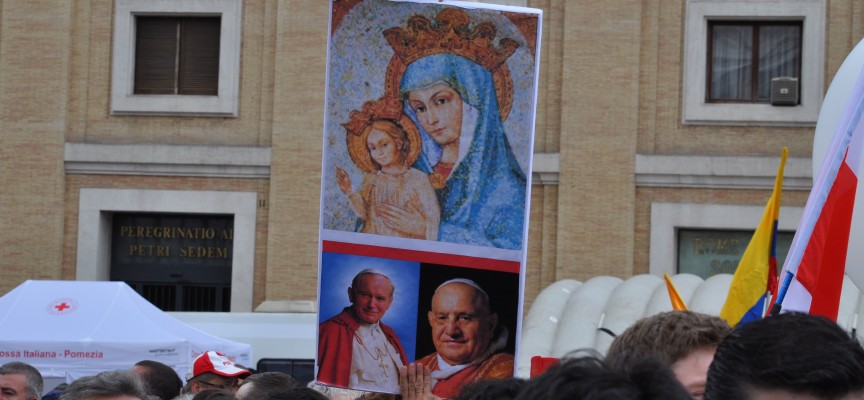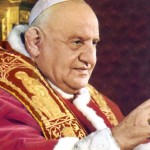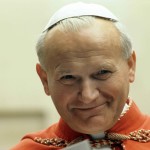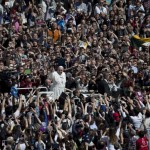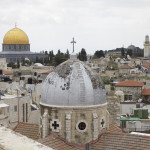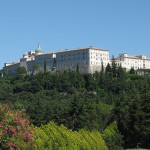Church has got two saints Popes. These personalities are similar to each other and very different at the same time. In his homily at the canonization Mass, Pope Francis stressed that both “were not afraid to look upon the wounds of Jesus, to touch his torn hands and his pierced side. They were not ashamed of the flesh of Christ, they were not scandalized by him, by his cross; they did not despise the flesh of their brother”. The wounds, being a stumbling block to the faith, do not disappear from the body of the Risen Lord, but remain as they are enduring signs of God’s love. They are essential for believing that God is love and mercy. The wounds outstretched to the disciples to touch them, are an invitation to give them a new meaning; to what was a sign of the curse, read as a sign of grace. “By his wounds you have been healed”.
Two holy popes. Each of them, Pope Francis gave a title which in a special way describes his mission. St. John XXIII was “the Pope of openness to the Holy Spirit”, St. John Paul II “Pope of the family”. The first is closely related to the convening of the Second Vatican Council. The second to the special importance attached by Pope John Paul II to family issues. There were personal reasons for doing so – early orphanhood and the understanding of the family value through the experience of “missing”. This shows how much for the promotion of the family can do all those who are actually experiencing family crises, any deficiencies in relation to the ideal of what a man carries in his heart. Other reasons is probably associated with the history of the nation, which for two centuries was deprived of independent state. Through these two centuries the Catholic faith and national identity were stored and transmitted in the family, “under the mother’s heart”. The Pope spoke of this in UNESCO: “I am the son of a Nation which has lived through the greatest vicissitudes of history, which its neighbours have condemned to death more than once, and yet which has survived and remained itself. It has kept its identity, and despite partition and foreign occupation, it has maintained its national sovereignty not by depending on the resources of physical force but solely by relying on its culture. In the case in point, that culture has proved more powerful than all other forces combined”. Finally, Saint. John Paul II was deeply aware that the family, the Ecclesia domestica and fundamental cell of the society, is experiencing a serious crisis today. Hence the papal catechesis on the theology of the body, Letter to Women, Letter to Families, and finally the establishment of the Pontifical Council for the Family. Hence the constant reminders that “man cannot fully find himself, except through a sincere gift of himself”, that man needs to live not just “next to” but “for” husband or wife, that children are a sign of God’s blessing, that spouses are called to be a visible sign to the world of faithful and irrevocable love of Christ to the Church.
It seems that the family in a special way connects to the contemplation of the five wounds of Christ. Man sometimes wants love that costs nothing. Abortion, euthanasia, divorce are different ways of escape from suffering, suffering which is a test of both faith and love. “In these two men, who looked upon the wounds of Christ and bore witness to his mercy, there dwelt a living hope and an indescribable and glorious joy”. The wounds outstretched to the spouses in crisis seem to exorcise fear, they seem to say: “Do not be afraid! My love won the world”. Love having the courage to watch the wounds of Jesus “bears everything, endures everything and never ceases”.
The Pope Francis, in a sense, has proclaimed Saint John Paul II patron of the Synod devoted to the family. It’s a very good sign and a reminder that the teaching of John Paul II on the family is no longer “just” the teaching of a pope of the recent past, but it is also the teaching of the saint.
Undoubtedly, today we do not need another, that is, a “second” Church. But we need the Church of Jesus Christ, which renews herself continuously, updating in keeping with her pristine features, in docility to the Holy Spirit. “Let us not forget that it is the saints who give direction and growth to the Church”.
Kościołowi przybyło dwóch świętych papieżu. To osobowości podobne do siebie i bardzo różne zarazem. W homilii na Mszy kanonizacyjnej papież Franciszek podkreślił, że obaj „mieli odwagę oglądania ran Jezusa, dotykania Jego zranionych rąk i Jego przebitego boku. Nie wstydzili się ciała Chrystusa, nie gorszyli się Nim, Jego krzyżem”. Rany, będące zgorszeniem dla wiary, nie znikają z ciała Zmartwychwstałego, lecz pozostają, gdyż są trwałym znakiem miłości Boga. Są niezbędne, by wierzyć, że Bóg jest miłością i miłosierdziem. Rany wyciągnięte ku uczniom, aby mogli ich dotknąć, są zaproszeniem, by nadać im nowy sens; by to, co było znakiem przekleństwa, odczytać jako znak łaski. „W Jego ranach jest nasze zbawienie”.
Dwóch świętych papież. Każdemu z nich papież Franciszek „nadał” tytuł w sposób szczególny opisujący jego misję. Św. Jan XXIII był „papieżem posłuszeństwa Duchowi Świętemu”, św. Jan Paweł II – „papieżem rodziny”. Pierwsze wiąże się ściśle ze zwołaniem Soboru Watykańskiego II. Drugie – ze szczególną wagą przywiązywaną przez Jana Pawła II do kwestii rodziny. Istniały ku temu powody osobiste – wczesne osierocenie i odkrywanie wartości rodziny poprzez doświadczenie „braku”. Ukazuje to, jak wiele dla promocji rodziny mogą zrobić ci wszyscy, którzy właściwie przeżywają rodzinne kryzysy, wszelkie braki w stosunku do ideału, jaki człowiek nosi w sercu. Inne powody wiązały się chyba z historią narodu, który przez dwa wieki pozbawiony był własnej państwowości. Przez te dwa wieki wiara katolicka i narodowa tożsamość były przechowywane i przekazywane w rodzinach, „pod sercem matek”. Mówił o tym Papież w UNESCO: „Jestem synem Narodu, który przetrwał najstraszliwsze doświadczenia dziejów, który wielokrotnie sąsiedzi skazywali na śmierć – a on pozostał przy życiu i pozostał sobą. Zachował własną tożsamość i zachował pośród rozbiorów i okupacji własną suwerenność jako Naród – nie w oparciu o jakiekolwiek inne środki fizycznej potęgi, ale tylko w oparciu o własną kulturę, która okazała się w tym wypadku potęgą większą od tamtych potęg”. Wreszcie, św. Jan Paweł II był głęboko świadomy, że rodzina, Ecclesia domestica i podstawowa komórka społeczeństwa, przeżywa dzisiaj poważny kryzys. Stąd papieskie katechezy o teologii ciała, List do kobiet, List do rodzin, a wreszcie powołanie Papieskiej Rady do spraw Rodziny. Stąd ciągłe przypominanie, że „człowiek nie może siebie w pełni zrealizować inaczej, jak poprzez bezinteresowny dar z siebie”, o potrzebie życia nie tylko „obok”, ale „dla” męża czy żony, o tym, że dzieci są znakiem błogosławieństwa Bożego, że małżonkowie są powołani do tego, aby być dla świata widzialnym znakiem miłości wiernej i nieodwołanej Chrystusa do Kościoła.
Wydaje się, że temat rodziny w szczególny sposób łączy się z kontemplacją pięciu ran Chrystusa. Człowiek niekiedy pragnie miłości, która nic nie kosztuje. Aborcja, eutanazja, rozwody, to różne sposoby ucieczki od cierpienia, które jest sprawdzianem zarówno wiary, jak i miłości. „W tych dwóch ludziach kontemplujących rany Chrystusa i świadkach Jego miłosierdzia była „żywa nadzieja” wraz z „radością niewymowną i pełną chwały”. Rany wyciągnięte ku małżonkom przeżywającym kryzys zdają się egzorcyzmować strach, zdają się mówić: „Przestań się lękać! Moja miłość zwyciężyła świat”. Miłość mająca odwagę oglądania ran Jezusa „wszystko znosi, wszystko przetrzyma, nigdy nie ustaje”.
Papież Franciszek poniekąd ogłosił św. Jana Pawła II patronem synodu poświęconego rodzinie. To bardzo dobry znak i przypomnienie, że nauczanie Jana Pawła II na temat rodziny nie jest już „tylko” nauczaniem papieża z niedawnej przeszłości, ale jest także nauczaniem świętego.
Niewątpliwie, nie potrzebujemy dzisiaj innego, to znaczy jakiegoś „drugiego” Kościoła. Potrzebuje jednak Kościoła, który odnawia się nieustannie i odzyskuje swoją pierwotną fizjonomię w posłuszeństwie Duchowi Świętemu. „Nie zapominajmy, że to właśnie święci prowadzą Kościół naprzód i sprawiają, że się rozwija”.
Un segno di grazia
La Chiesa ha ricevuto due santi papi. Queste personalità sono simili tra loro e molto diverse allo stesso tempo. Nella sua omelia della Messa di canonizzazione, papa Francesco ha sottolineato che entrambi “hanno avuto il coraggio di guardare le ferite di Gesù, di toccare le sue mani piagate e il suo costato trafitto. Non hanno avuto vergogna della carne di Cristo, non si sono scandalizzati di Lui, della sua croce; non hanno avuto vergogna della carne del fratello, perché in ogni persona sofferente vedevano Gesù”. Le piaghe, essendo uno scandalo per la fede, non scompaiono dal corpo del Signore risorto, ma rimangono come il segno permanente dell’amore di Dio. Sono indispensabili per credere che Dio è amore e misericordia. Le piaghe tese verso i discepoli perché le toccassero sono un invito a dare loro un nuovo significato; a leggere quello che era un segno di maledizione come un segno di grazia. “Dalle sue piaghe siete stati guariti”.
Due papi santi. A ognuno di loro il papa Francesco ha dato un titolo che, in un modo speciale, descrive la sua missione. San Giovanni XXIII era “il Papa della docilità allo Spirito Santo”. San Giovanni Paolo II “il Papa della famiglia”. Il primo è strettamente legato alla convocazione del Concilio Vaticano II. Il secondo alla particolare importanza attribuita alle questioni familiari.
C’erano motivi personali nella vita di Karol Wojtyła per farlo: presto orfano, ha esplorato il valore della famiglia attraverso l’esperienza della “mancanza”. Questo mostra quanto per la promozione della famiglia possono fare tutti coloro che vivono crisi familiari, tutti i difetti in relazione all’ideale che l’uomo porta nel cuore. Altri motivi probabilmente sono legati alla storia della nazione, che per due secoli è stata privata dell’indipendenza. Attraverso questi due secoli la fede cattolica e l’identità nazionale sono state conservate e trasmesse nelle famiglie “sotto il cuore delle madri”. Giovanni Paolo ha parlato di questo all’Unesco: “Io sono figlio di una nazione che ha vissuto le più grandi esperienze della storia, che i suoi vicini hanno condannato a morte a più riprese, ma che è sopravvissuta e che è rimasta se stessa. Essa ha conservato la sua identità e ha conservato, nonostante le spartizioni e le occupazioni straniere, la sua sovranità nazionale, non appoggiandosi sulle risorse della forza fisica, ma unicamente appoggiandosi sulla sua cultura. Questa cultura si è rivelata all’occorrenza d’una potenza più grande di tutte le altre forze”. Infine, san Giovanni Paolo II era profondamente consapevole che la famiglia, Ecclesia domestica e cellula fondamentale della società, sta vivendo oggi una grave crisi. Da qui le catechesi del Papa sulla teologia del corpo, la Lettera alle donne, la Lettera alle famiglie e, infine, l’istituzione del Pontificio consiglio per la famiglia. Da qui i continui richiami che “l’uomo non può ritrovarsi pienamente se non attraverso un dono sincero di sé”, la necessità della vita non solo “con” il prossimo, ma “per” il marito o la moglie; che i bambini sono un segno della benedizione di Dio, che i coniugi sono chiamati a essere nel mondo un segno visibile di amore fedele e irrevocabile di Cristo alla Chiesa.
Sembra che la famiglia in modo speciale si colleghi alla contemplazione delle cinque piaghe di Cristo. L’uomo a volte vuole l’amore che “costa niente”. L’aborto, l’eutanasia, il divorzio sono nella nostra civiltà i diversi modi di fuga dalla sofferenza, ch’è una verifica di fede e di amore. “In questi due uomini contemplativi delle piaghe di Cristo e testimoni della sua misericordia dimorava ‘una speranza viva’, insieme con una ‘gioia indicibile e gloriosa’”. Le piaghe tese verso i coniugi in crisi sembrano esorcizzare la paura, sembrano dire: “Non abbiate paura! Il mio amore ha vinto il mondo”. L’amore che ha il coraggio di guardare le piaghe di Gesù “sopporta tutto, crede in tutto, non cessa mai”.
Papa Francesco, in un senso, ha proclamato san Giovanni Paolo II patrono del Sinodo dedicato alla famiglia. È un buon segno ma anche un promemoria che l’insegnamento di Giovanni Paolo II sulla famiglia non è più “solo” un insegnamento di un papa del recente passato, ma è anche l’insegnamento di un santo.
Senza dubbio, oggi non abbiamo bisogno di una “seconda” Chiesa. Abbiamo bisogno della Chiesa di Gesù, che si rinnova continuamente, che scopre la sua fisionomia originaria in docilità allo Spirito Santo. “Non dimentichiamo che sono proprio i santi che mandano avanti e fanno crescere la Chiesa”, in docilità allo Spirito Santo.
Piotr Mazurkiewicz
Latest posts by Piotr Mazurkiewicz (see all)
- End of life: what is the true right? - 31 dicembre 2014
- Reflect on the fragility - 31 luglio 2014
- The value of marriage - 25 luglio 2014

